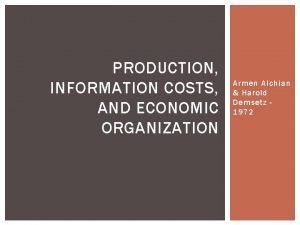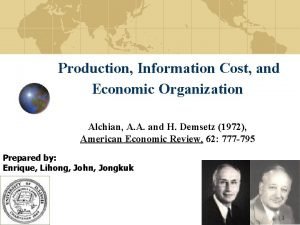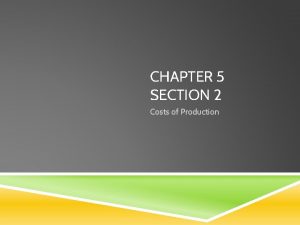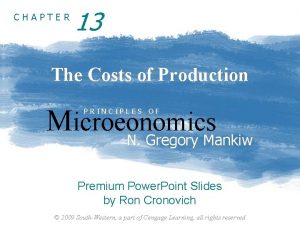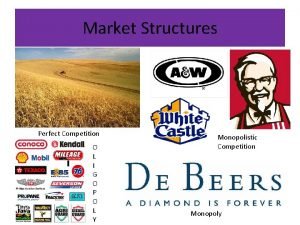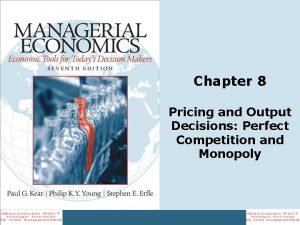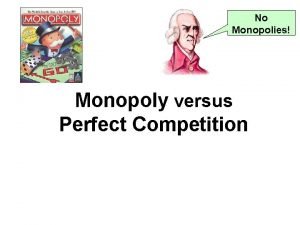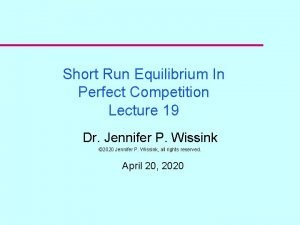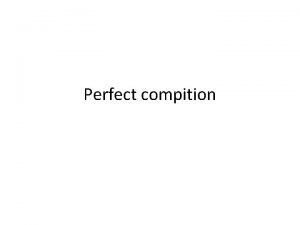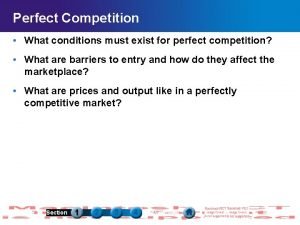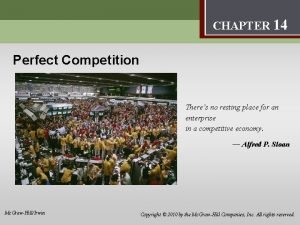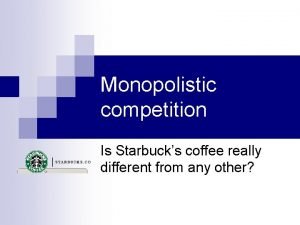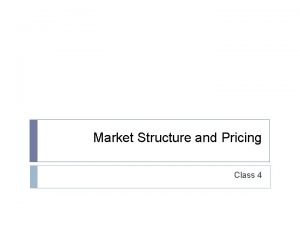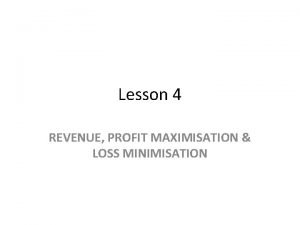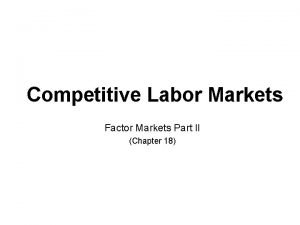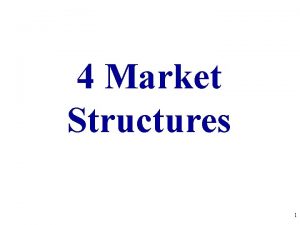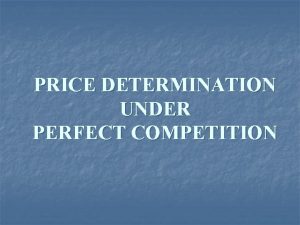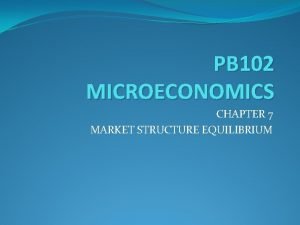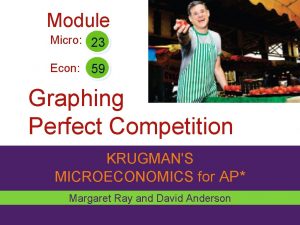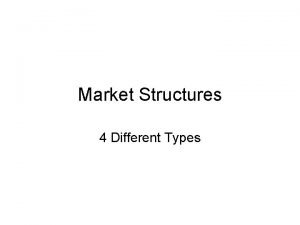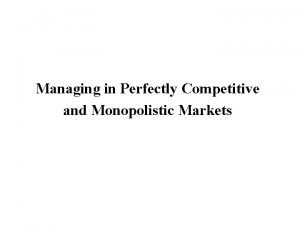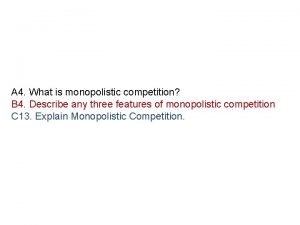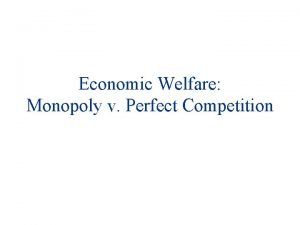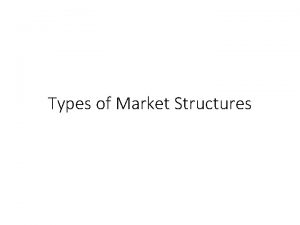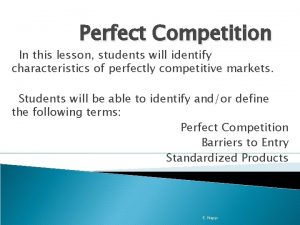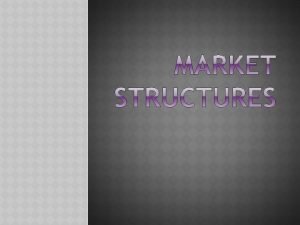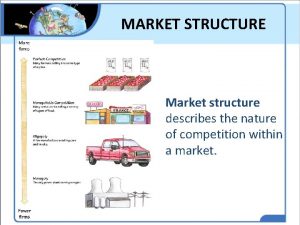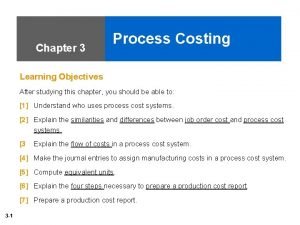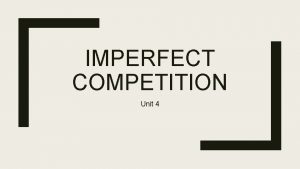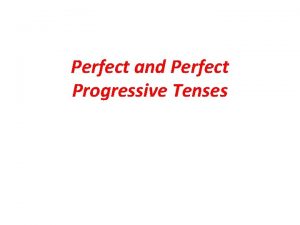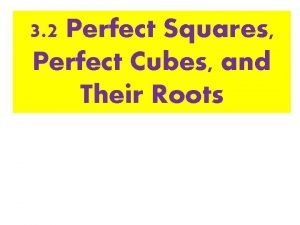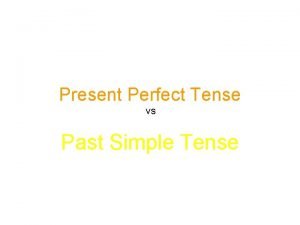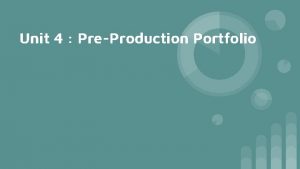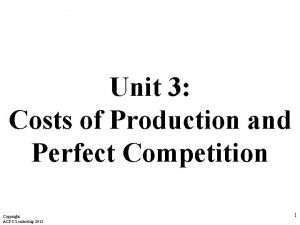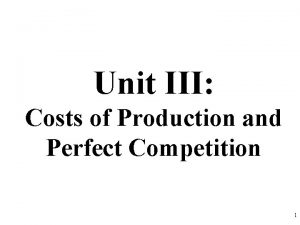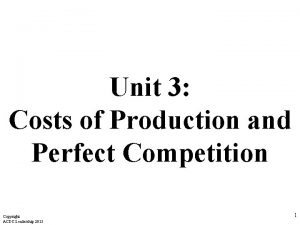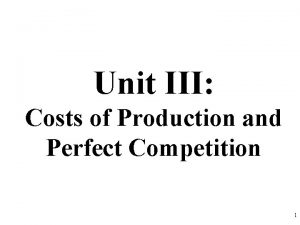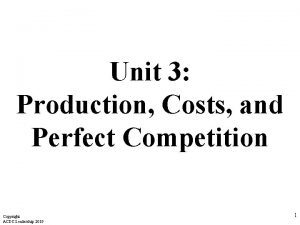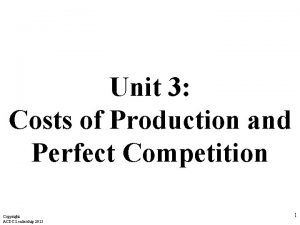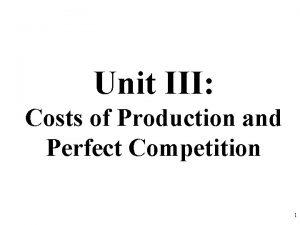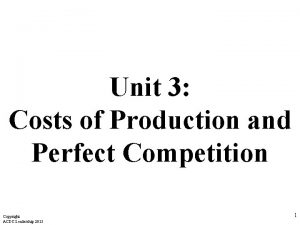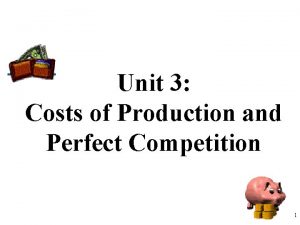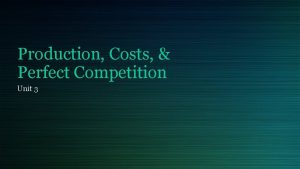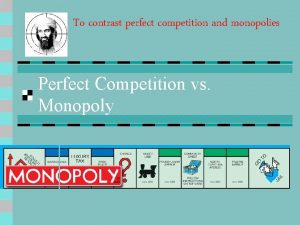Unit 3 Costs of Production and Perfect Competition




































































- Slides: 68

Unit 3: Costs of Production and Perfect Competition 1

Production = Converting inputs into output 2

Inputs and Outputs • To earn profit, firms must make products (output) • Inputs are the resources used to make outputs. • Input resources are also called FACTORS. • Total Physical Product (TP)- total output or quantity produced • Marginal Product (MP)- the additional output generated by additional inputs (workers). Marginal Product = Change in Total Product Change in Inputs • Average Product (AP)- the output per unit of input Average Product = Total Product Units of Labor 3

Production Analysis • What happens to the Total Product as you hire more workers? • What happens to marginal product as you hire more workers? • Why does this happens? The Law of Diminishing Marginal Returns As variable resources (workers) are added to fixed resources (machinery, tool, etc. ), the additional output produced from each new worker will eventually fall. Too many cooks in the kitchen! 4

Bellringer answers 5 10 4 1 0 2 As variable resources are added to fixed resources, the additional output for each new worker will eventually fall. After the 2 nd worker. 5

Graphing Production 6

Three Stages of Returns Stage I: Increasing Marginal Returns MP rising. TP increasing at an increasing rate. Why? Specialization. Total Product Quantity of Labor Marginal and Average Product Marginal Product Quantity of Labor 7

Three Stages of Returns Stage II: Decreasing Marginal Returns MP Falling. TP increasing at a decreasing rate. Why? Fixed Resources. Each worker adds less and less. Total Product Quantity of Labor Marginal and Average Product Marginal Product Quantity of Labor 8

Three Stages of Returns Stage III: Negative Marginal Returns MP is negative. TP decreasing. Workers get in each others way Total Product Quantity of Labor Marginal and Average Product Marginal Product Quantity of Labor 9

The Law of Diminishing Marginal Returns is NOT the results of laziness, it is the result of limited fixed resources. 10

Collaborate to calculate MP and AP then discuss what the graphs for TP, MP, and AP look like. Remember quantity of workers goes on the x-axis. # of Workers Total Product(TP) Marginal PIZZAS Product(MP) (Input) 0 1 2 3 4 5 6 7 8 0 10 25 45 60 70 75 75 70 Average Product(AP) 11

Collaborate to calculate MP and AP then discuss what the graphs for TP, MP, and AP look like. Remember quantity of workers goes on the x-axis. # of Workers Total Product(TP) Marginal PIZZAS Product(MP) (Input) 0 1 2 3 4 5 6 7 8 0 10 25 45 60 70 75 75 70 - Average Product(AP) - 10 15 20 15 10 5 0 -5 12

Collaborate to calculate MP and AP then discuss what the graphs for TP, MP, and AP look like. Remember quantity of workers goes on the x-axis. # of Workers Total Product(TP) Marginal PIZZAS Product(MP) (Input) 0 1 2 3 4 5 6 7 8 0 10 25 45 60 70 75 75 70 Average Product(AP) - - 10 10 15 12. 5 20 15 15 15 10 14 5 12. 5 0 10. 71 -5 8. 75 13

Identify the three stages of returns # of Workers Total Product(TP) Marginal PIZZAS Product(MP) (Input) 0 1 2 3 4 5 6 7 8 0 10 25 45 60 70 75 75 70 Average Product(AP) - - 10 10 15 12. 5 20 15 15 15 10 14 5 12. 5 0 10. 71 -5 8. 75 14

Identify the three stages of returns # of Workers Total Product(TP) Marginal PIZZAS Product(MP) (Input) 0 0 rns 10 1 u t e l. R a n i arg M 2 sing 25 a re Inc 3 45 4 60 s n tur e R 5 70 al n i g r Ma g 6 reasin 75 c De 7 75 8 Negative Marginal Returns 70 Average Product(AP) - - 10 10 15 12. 5 20 15 15 15 10 14 5 12. 5 0 10. 71 -5 8. 75 15

More Examples of the Law of Diminishing Marginal Returns Example #1: Learning curve when studying for an exam Fixed Resources-Amount of class time, textbook, etc. Variable Resources-Study time at home Marginal return§ 1 st hour-large returns § 2 nd hour-less returns § 3 rd hour-small returns § 4 th hour- negative returns (tired and confused) Example #2: A Farmer has fixed resource of 8 acres planted of corn. If he doesn’t clear weeds he will get 30 bushels. If he clears weeds once he will get 50 bushels. Twice -57, Thrice-60. Additional returns diminishes each 16 time.

Watch • Episode 22 mjmfoodie on Youtube 17

Costs of Production 18

Accountants vs. Economists Accountants look at only EXPLICIT COSTS • Explicit costs (out of pocket costs) are payments paid by firms for using the resources of others. • Example: Rent, Wages, Materials, Electricity Bills Accounting Profit Total Revenue Accounting Costs (Explicit Only) Economists examine both the EXPLICIT COSTS and the IMPLICIT COSTS • Implicit costs are the opportunity costs that firms “pay” for using their own resources • Example: Forgone Wage, Forgone Rent, Time Economic Profit Total Revenue Economic Costs (Explicit + Implicit) 19

Accountants vs. Economists Accountants look at only EXPLICIT COSTS • Explicit costs (out of pocket costs) are payments paid by firms for using the resources of others. • Example: Rent, Wages, Materials, Electricity Bills Accounting Profit Total Revenue Accounting Costs (Explicit Only) Economists examine both the EXPLICIT COSTS and the IMPLICIT COSTS • Implicit costs are the opportunity costs that firms “pay” for using their own resources • Example: Forgone Wage, Forgone Rent, Time Economic Profit Total Revenue Economic Costs (Explicit + Implicit) 20

Watch Episode 23, mjmfoodie on Youtube 21

Short-Run Production Costs Textbook Ch 13, sections 13. 3 and 13. 4 22

Definition of the “Short-Run” • We will look at both short-run and long-run production costs. • Short-run is NOT a set specific amount of time. • The short-run is a period in which at least one resource is fixed. – Plant capacity/size is NOT changeable • In the long-run ALL resources are variable – NO fixed resources – Plant capacity/size is changeable Today we will examine Short-run costs. 23

Different Economic Costs Total Costs FC = Total Fixed Costs VC = Total Variable Costs TC = Total Costs Per Unit Costs AFC = Average Fixed Costs AVC = Average Variable Costs ATC = Average Total Costs MC = Marginal Cost 24

Definitions Fixed Costs: Costs for fixed resources that DON’T change with the amount produced Ex: Rent, Insurance, Managers Salaries, etc. Average Fixed Costs = Fixed Costs Quantity Variable Costs: Costs for variable resources that DO change as more or less is produced Ex: Raw Materials, Labor, Electricity, etc. Variable Costs Average Variable Costs = Quantity 25

Definitions Total Cost: Sum of Fixed and Variable Costs Average Total Cost = Total Costs Quantity Marginal Cost: Additional costs of an additional output. Ex: If the production of two more output increases total cost from $100 to $120, the MC $10 is _____. Change in Total Costs Marginal Cost = Change in Quantity 26

Calculating TC, VC, FC, ATC, AFC, and MC TP 0 1 2 3 4 5 6 7 VC 0 10 16 21 26 30 36 46 FC 100 TC MC AVC AFC ATC Draw this in your notes 27

Calculating TC, VC, FC, ATC, AFC, and MC TP 0 1 2 3 4 5 6 7 VC 0 10 16 21 26 30 36 46 FC 100 100 TC MC AVC AFC ATC 28

Calculating TC, VC, FC, ATC, AFC, and MC TP 0 1 2 3 4 5 6 7 VC 0 10 16 21 26 30 36 46 FC 100 100 TC 100 116 121 126 130 136 146 MC AVC AFC ATC 29

TOTAL COSTS GRAPHICALLY 800 Costs (dollars) 700 600 Combining VC With FC to get Total Cost TC VC Fixed Cost 500 400 300 200 100 FC 0 0 1 2 3 4 5 6 7 8 9 10 11 12 13 14 15 Quantity 30

TOTAL COSTS GRAPHICALLY 800 Costs (dollars) 700 600 500 400 300 200 100 Combining VC With FC to get Total Cost TC VC Fixed Cost What is the TOTAL COST, FC, and VC for producing 9 units? FC 0 0 1 2 3 4 5 6 7 8 9 10 11 12 13 14 15 Quantity 31

Per Unit Costs TP 0 1 2 3 4 5 6 7 VC 0 10 16 21 26 30 36 46 FC 100 100 TC 100 116 121 126 130 136 146 MC - AVC AFC ATC 32

Per Unit Costs TP 0 1 2 3 4 5 6 7 VC 0 10 16 21 26 30 36 46 FC 100 100 TC 100 116 121 126 130 136 146 MC 10 6 5 5 4 6 10 AVC AFC ATC 33

Per Unit Costs TP 0 1 2 3 4 5 6 7 VC 0 10 16 21 26 30 36 46 FC 100 100 TC 100 116 121 126 130 136 146 MC 10 6 5 5 4 6 10 AVC AFC ATC 10 8 7 6. 5 6 6 6. 6 34

Per Unit Costs TP 0 1 2 3 4 5 6 7 VC 0 10 16 21 26 30 36 46 FC 100 100 TC 100 116 121 126 130 136 146 MC 10 6 5 5 4 6 10 AVC AFC ATC 10 100 8 50 7 33. 3 6. 5 25 6 20 6 16. 67 6. 6 14. 3 Asymptote 35

Per Unit Costs TP 0 1 2 3 4 5 6 7 VC 0 10 16 21 26 30 36 46 FC 100 100 TC 100 116 121 126 130 136 146 MC 10 6 5 5 4 6 10 AVC AFC ATC 10 100 110 8 50 58 7 33. 3 40. 3 6. 5 25 31. 5 6 20 26 6 16. 67 22. 67 6. 6 14. 3 20. 9 36

Per Unit Costs TP 0 1 2 3 4 5 6 7 VC 0 10 16 21 26 30 36 46 FC 100 100 TC 100 116 121 126 130 136 146 MC 10 6 5 5 4 6 10 AVC AFC ATC 10 100 110 8 50 58 7 33. 3 40. 3 6. 5 25 31. 5 6 20 26 6 16. 67 22. 67 6. 6 14. 3 20. 9 37

Per-Unit Costs (Average and Marginal) Costs (dollars) MC 12 11 10 9 8 7 6 5 4 3 2 1 ATC AVC How much does the 11 th unit costs? AFC 0 1 2 3 4 5 6 7 8 9 10 11 12 13 14 15 Quantity 38

Per-Unit Costs (Average and Marginal) Costs (dollars) Graphing the MC, ATC, AVC, and AFC curves. 12 11 10 9 8 7 6 5 4 3 2 1 0 1 2 3 4 5 6 7 8 9 10 11 12 13 14 15 Quantity 39

Per-Unit Costs (Average and Marginal) Costs (dollars) MC 12 11 10 9 8 7 6 5 4 3 2 1 ATC and AVC get closer and closer but NEVER touch ATC AVC Average Fixed Cost AFC 0 1 2 3 4 5 6 7 8 9 10 11 12 13 14 15 Quantity 40

Per-Unit Costs (Average and Marginal) At output Q, what area represents: TC 0 CDQ VC 0 BEQ FC 0 AFQ or BCDE 41

Costs (dollars) Why is the MC curve U-shaped? 12 11 10 9 8 7 6 5 4 3 2 1 MC 0 1 2 3 4 5 6 7 8 9 10 11 12 13 14 15 Quantity 42

Costs Marginal Product Relationship between Production and Cost Why is the MC curve Ushaped? • When marginal product is increasing, marginal cost falls. Quantity of labor • When marginal product falls, MC marginal costs increase. MP and MC are mirror images of each other. MP Quantity of output 43

Why is the MC curve U-shaped? • The MC curve falls and then rises because of diminishing marginal returns. • Example: • Assume the fixed cost is $20 and the ONLY variable cost is the cost for each worker ($10) Workers Total Prod Marg Prod Total Cost Marginal Cost 0 0 1 5 2 13 3 19 4 23 5 25 6 26 44

Why is the MC curve U-shaped? • The MC curve falls and then rises because of diminishing marginal returns. • Example: • Assume the fixed cost is $20 and the ONLY variable cost is the cost for each worker ($10) Workers Total Prod Marg Prod Total Cost Marginal Cost 0 0 1 5 5 2 13 8 3 19 6 4 23 4 5 25 2 6 26 1 45

Why is the MC curve U-shaped? • The MC curve falls and then rises because of diminishing marginal returns. • Example: • Assume the fixed cost is $20 and the ONLY variable cost is the cost for each worker (Wage = $10) Workers Total Prod Marg Prod Total Cost Marginal Cost 0 0 $20 1 5 5 $30 2 13 8 $40 3 19 6 $50 4 23 4 $60 5 25 2 $70 6 26 1 $80 46

Why is the MC curve U-shaped? • The MC curve falls and then rises because of diminishing marginal returns. • Example: • Assume the fixed cost is $20 and the ONLY variable cost is the cost for each worker ($10) Workers Total Prod Marg Prod Total Cost Marginal Cost 0 0 $20 1 5 5 $30 10/5 = $2 2 13 8 $40 10/8 = $1. 25 3 19 6 $50 10/6 = $1. 6 4 23 4 $60 10/4 = $2. 5 5 25 2 $70 10/2 = $5 6 26 1 $80 10/1 = $10 47

Why is the MC curve U-shaped? • The additional cost of the first 13 units produced falls because workers have increasing marginal returns. • As production continues, each worker adds less and less to production so the marginal cost for each unit increases. Workers Total Prod Marg Prod Total Cost Marginal Cost 0 0 $20 1 5 5 $30 10/5 = $2 2 13 8 $40 10/8 = $1. 25 3 19 6 $50 10/6 = $1. 6 4 23 4 $60 10/4 = $2. 5 5 25 2 $70 10/2 = $5 6 26 1 $80 10/1 = $10 48

Costs (dollars) Aver m Relationship. MP between Production and Cost Why is the ATC curve UQuantity of labor MC shaped? • When the marginal cost is below the average, it pulls ATC the average down. • When the marginal cost is above the average, it pulls Quantity of output the average up. The MC curve intersects the ATC curve at its lowest point. Example: • The average income in the room is $50, 000. • An additional (marginal) person enters the room: Bill Gates. • If the marginal is greater than the average it pulls it up. • Notice that MC can increase but still pull down the average. 49

Shifting Cost Curves 50

Shifting Costs Curves TP 0 1 2 3 4 5 6 7 VC 0 10 16 21 26 30 36 46 FC 100 100 TC 100 116 121 126 130 136 146 MC 10 6 5 3 4 6 10 AVC AFC ATC 10 100 110 8 50 58 7 33. 3 40. 3 6. 5 25 31. 5 6 20 26 6 16. 67 22. 67 6. 6 14. 3 20. 9 What if Fixed Costs increase to $200 51

Shifting Costs Curves TP 0 1 2 3 4 5 6 7 VC 0 10 16 21 26 30 36 46 FC 100 100 TC 100 116 121 126 130 136 146 MC 10 6 5 5 4 6 10 AVC AFC ATC 10 100 110 8 50 58 7 33. 3 40. 3 6. 5 25 31. 5 6 20 26 6 16. 67 22. 67 6. 6 14. 3 20. 9 52

Shifting Costs Curves TP 0 1 2 3 4 5 6 7 VC 0 10 16 21 26 30 36 46 FC 200 200 TC 100 116 121 126 130 136 146 MC 10 6 5 5 4 6 10 AVC AFC ATC 10 100 110 8 50 58 7 33. 3 40. 3 6. 5 25 31. 5 6 20 26 6 16. 67 22. 67 6. 6 14. 3 20. 9 53

Shifting Costs Curves TP 0 1 2 3 4 5 6 7 VC 0 10 16 21 26 30 36 46 FC 200 200 TC 200 216 221 226 230 236 246 MC 10 6 5 5 4 6 10 AVC AFC ATC 10 100 110 8 50 58 7 33. 3 40. 3 6. 5 25 31. 5 6 20 26 6 16. 67 22. 67 6. 6 14. 3 20. 9 Which Per Unit Cost Curves Change? 54

Shifting Costs Curves TP 0 1 2 3 4 5 6 7 VC 0 10 16 21 26 30 36 46 FC 200 200 TC 200 216 221 226 230 236 246 MC 10 6 5 5 4 6 10 AVC AFC ATC 10 100 110 8 50 58 7 33. 3 40. 3 6. 5 25 31. 5 6 20 26 6 16. 67 22. 67 6. 6 14. 3 20. 9 ONLY AFC and ATC Increase! 55

Shifting Costs Curves TP 0 1 2 3 4 5 6 7 VC 0 10 16 21 26 30 36 46 FC 200 200 TC 200 216 221 226 230 236 246 MC 10 6 5 5 4 6 10 AVC AFC ATC 10 200 110 8 100 58 7 66. 6 40. 3 6. 5 50 31. 5 6 40 26 6 33. 3 22. 67 6. 6 28. 6 20. 9 ONLY AFC and ATC Increase! 56

Shifting Costs Curves If fixed costs change ONLY AFC and ATC Change! TP 0 1 2 3 4 5 6 7 VC 0 10 16 21 26 30 36 46 FC 200 200 TC 200 216 221 226 230 236 246 MC 10 6 5 5 4 6 10 AVC AFC ATC 10 200 210 8 100 108 7 66. 6 73. 6 6. 5 50 56. 5 6 40 46 6 33. 3 39. 3 6. 6 28. 6 35. 2 MC and AVC DON’T change! 57

Shift from an increase in a Fixed Cost MC Costs (dollars) ATC 1 ATC AVC AFC 1 AFC Quantity 58

Shift from an increase in a Fixed Cost MC Costs (dollars) ATC 1 AVC AFC 1 Quantity 59

Shifting Costs Curves TP 0 1 2 3 4 5 6 7 VC 0 10 16 21 26 30 36 46 FC 100 100 TC 100 116 121 126 130 136 146 MC 10 6 5 5 4 6 10 AVC AFC ATC 10 100 110 8 50 58 7 33. 3 40. 3 6. 5 25 31. 5 6 20 26 6 16. 67 22. 67 6. 6 14. 3 20. 9 What if the cost for variable resources increase 60

Shifting Costs Curves TP 0 1 2 3 4 5 6 7 VC 0 10 16 21 26 30 36 46 FC 100 100 TC 100 116 121 126 130 136 146 MC 10 6 5 5 4 6 10 AVC AFC ATC 10 100 110 8 50 58 7 33. 3 40. 3 6. 5 25 31. 5 6 20 26 6 16. 67 22. 67 6. 6 14. 3 20. 9 61

Shifting Costs Curves TP 0 1 2 3 4 5 6 7 VC 0 11 18 24 30 35 43 55 FC 100 100 TC 100 116 121 126 130 136 146 MC 10 6 5 5 4 6 10 AVC AFC ATC 10 100 110 8 50 58 7 33. 3 40. 3 6. 5 25 31. 5 6 20 26 6 16. 67 22. 67 6. 6 14. 3 20. 9 62

Shifting Costs Curves TP 0 1 2 3 4 5 6 7 VC 0 11 18 24 30 35 43 55 FC 100 100 TC 100 111 118 124 130 135 143 155 MC 10 6 5 3 4 6 10 AVC AFC ATC 10 100 110 8 50 58 7 33. 3 40. 3 6. 5 25 31. 5 6 20 26 6 16. 67 22. 67 6. 6 14. 3 20. 9 Which Per Unit Cost Curves Change? 63

Shifting Costs Curves TP 0 1 2 3 4 5 6 7 VC 0 11 18 24 30 35 43 55 FC 100 100 TC 100 111 118 124 130 135 143 155 MC 11 7 6 6 5 8 12 AVC AFC ATC 10 100 110 8 50 58 7 33. 3 40. 3 6. 5 25 31. 5 6 20 26 6 16. 67 22. 67 6. 6 14. 3 20. 9 MC, AVC, and ATC Change! 64

Shifting Costs Curves TP 0 1 2 3 4 5 6 7 VC 0 11 18 24 30 35 43 55 FC 100 100 TC 100 111 118 124 130 135 143 155 MC 11 7 6 6 5 8 12 AVC AFC ATC 11 100 110 9 50 58 8 33. 3 40. 3 7. 5 25 31. 5 7 20 26 7. 16 16. 67 22. 67 7. 8 14. 3 20. 9 MC, AVC, and ATC Change! 65

Shifting Costs Curves If variable costs change MC, AVC, and ATC Change! TP 0 1 2 3 4 5 6 7 VC 0 11 18 24 30 35 43 55 FC 100 100 TC 100 111 118 124 130 135 143 155 MC 11 7 6 6 5 8 12 AVC AFC ATC 11 100 111 9 50 59 8 33. 3 41. 3 7. 5 25 32. 5 7 20 27 7. 16 16. 67 23. 83 7. 8 14. 3 22. 1 66

Shift from an increase in a Variable Costs MC 1 Costs (dollars) MC ATC 1 AVC 1 ATC AVC AFC Quantity 67

Shift from an increase in a Variable Costs MC 1 Costs (dollars) ATC 1 AVC 1 AFC Quantity 68
 Characteristic of monopoly
Characteristic of monopoly Perfect competition vs monopolistic competition
Perfect competition vs monopolistic competition Perfect competition vs monopolistic competition
Perfect competition vs monopolistic competition Carta alir proses pembuatan produk
Carta alir proses pembuatan produk Production, information costs, and economic organization
Production, information costs, and economic organization Production information costs and economic organization
Production information costs and economic organization Market structures venn diagram
Market structures venn diagram Chapter 5 section 2 costs of production
Chapter 5 section 2 costs of production Chapter 13 the cost of production
Chapter 13 the cost of production Types of production costs
Types of production costs Perfect tenses
Perfect tenses Short run and long run equilibrium in perfect competition
Short run and long run equilibrium in perfect competition Monopoly vs oligopoly
Monopoly vs oligopoly Pricing and output decisions in perfect competition
Pricing and output decisions in perfect competition 7dynamics
7dynamics Perfect competition short run and long run
Perfect competition short run and long run Difference between perfect competition and monopoly market
Difference between perfect competition and monopoly market Mr mc graph
Mr mc graph Difference between perfect competition and monopoly
Difference between perfect competition and monopoly Past perfect use
Past perfect use Perfect competition side by side graphs
Perfect competition side by side graphs Short run market supply curve
Short run market supply curve What is compition
What is compition Barriers to entry for perfect competition
Barriers to entry for perfect competition Long run supply curve
Long run supply curve Advantages of perfect competition
Advantages of perfect competition Many sellers many buyers
Many sellers many buyers Shutdown point in perfect competition
Shutdown point in perfect competition Is starbucks a perfect competition?
Is starbucks a perfect competition? Perfect competition examples pictures
Perfect competition examples pictures Barriers to entry for perfect competition
Barriers to entry for perfect competition Revenue maximisation point
Revenue maximisation point Factor market perfect competition
Factor market perfect competition Market structure dominated by a few large profitable firms
Market structure dominated by a few large profitable firms Perfect competion examples
Perfect competion examples Price determination under perfect competition
Price determination under perfect competition Short run equilibrium under perfect competition
Short run equilibrium under perfect competition Supernormal profit in perfect competition
Supernormal profit in perfect competition Graphing perfect competition
Graphing perfect competition Perfect competion examples
Perfect competion examples Consumer surplus in perfect competition
Consumer surplus in perfect competition Supernormal profit in perfect competition
Supernormal profit in perfect competition Perfect competition poster
Perfect competition poster Perfect competition quiz
Perfect competition quiz Deadweight loss perfect competition
Deadweight loss perfect competition Opposite of perfect competition
Opposite of perfect competition List the four conditions for perfect competition.
List the four conditions for perfect competition. Chapter 7 section 1 perfect competition worksheet answers
Chapter 7 section 1 perfect competition worksheet answers A market dominated by a single seller
A market dominated by a single seller Pros and cons of monopolistic competition
Pros and cons of monopolistic competition Perfect pitch challenge
Perfect pitch challenge Disadvantages of perfect competition
Disadvantages of perfect competition Market structure
Market structure Objective of process costing
Objective of process costing Unit 4 imperfect competition
Unit 4 imperfect competition Unit 10, unit 10 review tests, unit 10 general test
Unit 10, unit 10 review tests, unit 10 general test Change to present perfect tense
Change to present perfect tense Como se forma el past perfect simple
Como se forma el past perfect simple Past simple continuous perfect
Past simple continuous perfect Past continuous vs past perfect continuous
Past continuous vs past perfect continuous Perfect infinitve
Perfect infinitve Present perfect simple keywords
Present perfect simple keywords Which of the radicals are perfect squares or cubes
Which of the radicals are perfect squares or cubes Past simple v present perfect
Past simple v present perfect Perfect present progressive
Perfect present progressive Past perfect continuous
Past perfect continuous Chapter 3 perfect and perfect progressive tenses
Chapter 3 perfect and perfect progressive tenses Unit 4 pre production portfolio
Unit 4 pre production portfolio Unit 28 website production
Unit 28 website production




